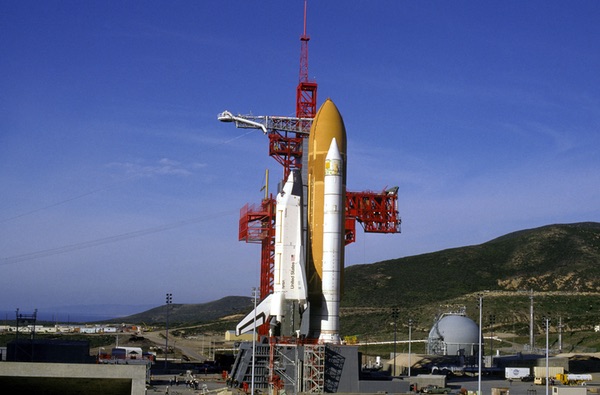Nuking Moscow with a Space Shuttleby Dwayne A. Day
|
| The report concluded that an American space shuttle, launched from Vandenberg Air Force Base in California and flying from south to north over the Soviet Union, could make a “dive” in its orbit as it passed over Moscow, and release a nuclear weapon. |
Russian researcher Pavel Shubin has recently uncovered and analyzed a March 1976 document that is the origin of the myth and published the results of his assessment. The document was written by Yu.G. Sikharulidze and Dmitry Okhotsimsky, who was then head of the department at the Institute of Applied Mathematics. The institute had played a major role in determining the trajectories of Soviet spacecraft through the atmosphere, and developing computer guidance for them.
The report concluded that an American space shuttle, launched from Vandenberg Air Force Base in California and flying from south to north over the Soviet Union, could make a “dive” in its orbit as it passed over Moscow, and release a nuclear weapon. This technique would enable a weapon to be deployed from the shuttle and detonate over Moscow 200 seconds later, far faster than an American submarine-launched ballistic missile could accomplish the same task. This nuclear dive-bombing would presumably be part of a knockout punch to destroy the Soviet command and control network before the USSR could launch a counter-strike.
According to Shubin, the report went to the Central Committee of the Communist Party where a debate took place, resulting in Soviet Premier Leonid Brezhnev ordering that a set of alternative measures be developed to secure the country from such an attack. Shubin writes that the report was circulated among several Soviet organizations and that it had a significant impact on the Soviet space program. But what the report actually said was not known publicly, and so over the decades it has only been told and retold and distorted by people who had never seen it. Shubin is the first to uncover it.
A 1973 internal NASA Johnson Space Center document had established requirements 3A and 3B for the shuttle. The first requirement was the ability to launch a large payload into polar orbit and return the shuttle to its launch site at Vandenberg. The 3B requirement was for the shuttle to launch into the same orbit and conduct a rapid rendezvous and retrieval of the same payload that would have been launched under requirement 3A. The shuttle then would have returned to the launch site, this time carrying 11,340 kilograms in its payload bay—the same mass as a large, secret reconnaissance satellite known as the HEXAGON. The 3A/3B requirements were reported publicly, and the authors of the 1976 report concluded that they reinforced their own assumptions about the shuttle’s dive-bombing mission.
One of the primary myths that developed in the Soviet Union and Russian space history circles was that the 1976 report was used to justify the Soviet Buran space shuttle. But Bart Hendrickx, a Belgian researcher and historian on Soviet and Russian space programs, wrote in his 2007 book Energiya-Buran: The Soviet Space Shuttle, that the decision to build the Buran actually pre-dated the report on the American shuttle’s alleged military capabilities by five weeks. How the March 1976 report actually influenced the development of Soviet space and defense policy remains to be explored. Shubin has focused on an interesting and little-examined period of Cold War space history, and hopefully we will see further assessments of this subject in the near future.
Note: we are temporarily moderating all comments submitted to deal with a surge in spam.
